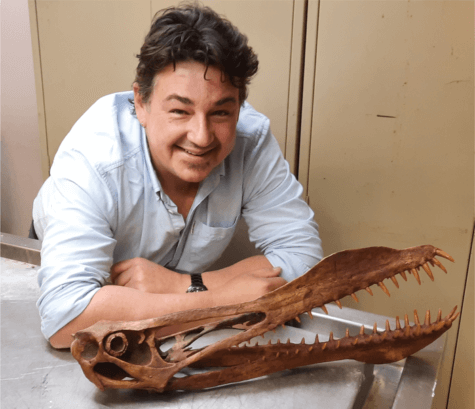(StudyFinds.org) — Dragons tend to be more of a myth than an actual creature we find in museums, but a new study reveals a terrifying reptile that swooped down from the sky to attack prehistoric prey may be the closest thing to these mythical beasts. Researchers in Australia say a massive pterosaur is the largest flying reptile ever discovered on the continent dating back to the age of the dinosaurs.
“It’s the closest thing we have to a real-life dragon,” says University of Queensland Ph.D. candidate Tim Richards in a media release.
“The new pterosaur, which we named Thapunngaka shawi, would have been a fearsome beast, with a spear-like mouth and a wingspan around seven meters. It was essentially just a skull with a long neck, bolted on a pair of long wings.”
“This thing would have been quite savage,” adds the researcher from the Dinosaur Lab in UQ’s School of Biological Sciences. “It would have cast a great shadow over some quivering little dinosaur that wouldn’t have heard it until it was too late.”
Study authors uncovered and analyzed a fossil of the Thapunngaka shawi’s jaw after finding it in Wanamara Country of North West Queensland.
A terror over land and sea

Tim Richards)
Richards reports that the skull of the flying reptile is over one meter long and contained around 40 teeth. Researchers believe this made the pterosaur’s jaw perfect for flying down to grab fish in Queensland’s ancient Eromanga Sea.
“It’s tempting to think it may have swooped like a magpie during mating season, making your local magpie swoop look pretty trivial – no amount of zip ties would have saved you,” Richards continues. “Though to be clear, it was nothing like a bird, or even a bat – Pterosaurs were a successful and diverse group of reptiles – the very first back-boned animals to take a stab at powered flight.”
Scientists add that the new fossil belongs to a group of pterosaurs called anhanguerians. The team says these creatures were found on every continent during the last days of the Age of Dinosaurs. Pterosaurs had generally hollow bones which were perfectly evolved for flying. Unfortunately, this makes finding fossils of them incredibly rare.
“It’s quite amazing fossils of these animals exist at all,” Richards explains. “By world standards, the Australian pterosaur record is poor, but the discovery of Thapunngaka contributes greatly to our understanding of Australian pterosaur diversity.”
The team adds that the new fossil is only the third anhanguerian pterosaur species discovered in Australia. Scientists discovered all three in western Queensland.
Did the dinosaur’s jaw help it fly better?
Dr. Steve Salisbury, co-author of the study and Richard’s Ph.D. supervisor, says the pterosaur’s jaw may have played a key role in the reptile’s ability to fly. Researchers discovered a massive bony crest on its lower jaw and believe one also appeared on its upper jaw too.
“These crests probably played a role in the flight dynamics of these creatures, and hopefully future research will deliver more definitive answers,” Dr. Salisbury explains.
The name of the new species honors the First Nations peoples of Australia’s Richmond area. Researchers originally uncovered the fossil here in 2011. The name also incorporates words from the now-extinct language of the Wanamara Nation.
“The genus name, Thapunngaka, incorporates thapun [ta-boon] and ngaka [nga-ga], the Wanamara words for ‘spear’ and ‘mouth’, respectively,” Dr. Salisbury concludes. “The species name, shawi, honours the fossil’s discoverer Len Shaw, so the name means ‘Shaw’s spear mouth.’”
The study appears in the Journal of Vertebrate Paleontology.




























